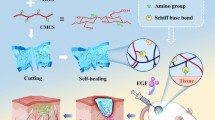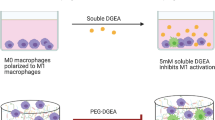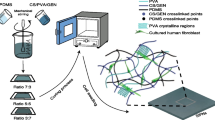Abstract
Purpose
Stratifin is a potent anti-fibrogenic factor that stimulates the expression of matrix metalloproteinase-1 (MMP-1) in dermal fibroblasts. The propose of this work was to develop a controlled release delivery system for stratifin that can be applied at the time of wound closure to release stratifin and stimulate the expression of MMP-1 in a sustained manner over the late stages of wound healing (after 3 days).
Methods
Stratifin was complexed to chitosan particles, which were then encapsulated in PLGA microspheres and blended into crosslinked hyaluronic acid films. In vitro release was assessed using fluorescent-tagged stratifin, cytotoxity by MTT assay and bioactivity by measuring the levels of MMP-1 expression in cultured fibroblasts.
Results
The release of stratifin was delayed for 3 days and then controlled for 30 days so that 60% of the total stratifin loaded was released. The released protein significantly stimulated the expression of MMP-1 in cultured fibroblasts without compromising cell viability. By complexing to chitosan, the initial burst release was reduced, so that only 5% of stratifin was released in 3 days.
Conclusion
This stratifin delivery sytem has the potential to be used as an anti-fibrogenic factor-associated wound insert for improving post-surgical scarring in closed wound.









Similar content being viewed by others
REFERENCES
Tredget EE, Nedelec B, Scott PG, Ghahary A. Hypertrophic scars, keloids, and contractures. The cellular and molecular basis for therapy. Surg Clin North Am. 1997;77:701–730. doi:10.1016/S0039-6109(05)70576-4.
Leventhal D, Furr M, Reiter D. Treatment of keloids and hypertrophic scars: a meta-analysis and review of the literature. Arch Facial Plast Surg. 2006;8:362–8. doi:10.1001/archfaci.8.6.362.
Ghahary A, Marcoux Y, Karimi-Busheri F, Li Y, Tredget EE, Kilani RT, et al. Differentiated keratinocyte-releasable stratifin (14–3-3 sigma) stimulates MMP-1 expression in dermal fibroblasts. J Invest Dermatol. 2005;124:170–7. doi:10.1111/j.0022-202X.2004.23521.x.
Ghahary A, Karimi-Busheri F, Marcoux Y, Li Y, Tredget EE, Taghi Kilani R, et al. Keratinocyte-releasable stratifin functions as a potent collagenase-stimulating factor in fibroblasts. J Invest Dermatol. 2004;122:1188–97. doi:10.1111/j.0022-202X.2004.22519.x.
Takeuchi M, Tredget EE, Scott PG, Kilani RT, Ghahary A. The antifibrogenic effects of liposome-encapsulated IFN-alpha2b cream on skin wounds. J Interferon Cytokine Res. 1999;19:1413–9. doi:10.1089/107999099312876.
Diwanand M, Park TG. Pegylation enhances protein stability during encapsulation in PLGA microspheres. J Control Release. 2001;73:233–44. doi:10.1016/S0168-3659(01)00292-9.
Sanchez A, Tobio M, Gonzalez L, Fabra A, Alonso MJ. Biodegradable micro- and nanoparticles as long-term delivery vehicles for interferon-alpha. Eur J Pharm Sci. 2003;18:221–9. doi:10.1016/S0928-0987(03)00019-8.
Li SH, Cai SX, Liu B, Ma KW, Wang ZP, Li XK. In vitro characteristics of poly(lactic-co-glycolic acid) microspheres incorporating gelatin particles loading basic fibroblast growth factor. Acta Pharmacol Sin. 2006;27:754–9. doi:10.1111/j.1745-7254.2006.00337.x.
Zheng CH, Gao JQ, Zhang YP, Liang WQ. A protein delivery system: biodegradable alginate-chitosan-poly(lactic-co-glycolic acid) composite microspheres. Biochem Biophys Res Commun. 2004;323:1321–7. doi:10.1016/j.bbrc.2004.09.007.
Geng Y, Yuan W, Wu F, Chen J, He M, Jin T. Formulating erythropoietin-loaded sustained-release PLGA microspheres without protein aggregation. J Control Release. 2008;130:259–65. doi:10.1016/j.jconrel.2008.06.011.
Lee KW, Yoon JJ, Lee JH, Kim SY, Jung HJ, Kim SJ, et al. Sustained release of vascular endothelial growth factor from calcium-induced alginate hydrogels reinforced by heparin and chitosan. Transplant Proc. 2004;36:2464–5. doi:10.1016/j.transproceed.2004.08.078.
DeFail AJ, Chu CR, Izzo N, Marra KG. Controlled release of bioactive TGF-beta 1 from microspheres embedded within biodegradable hydrogels. Biomaterials. 2006;27:1579–85. doi:10.1016/j.biomaterials.2005.08.013.
Kempen DH, Lu L, Hefferan TE, Creemers LB, Maran A, Classic KL, et al. Retention of in vitro and in vivo BMP-2 bioactivities in sustained delivery vehicles for bone tissue engineering. Biomaterials 2008;29:3245–52. doi:10.1016/j.biomaterials.2008.04.031.
Huang S, Deng T, Wu H, Chen F, Jin Y. Wound dressings containing bFGF-impregnated microspheres. J Microencapsul. 2006;23:277–90. doi:10.1080/02652040500435170.
Mi FL, Tan YC, Liang HF, Sung HW. In vivo biocompatibility and degradability of a novel injectable-chitosan-based implant. Biomaterials 2002;23:181–91. doi:10.1016/S0142-9612(01)00094-1.
Chen J, Yang WL, Li G, Qian J, Xue JL, Fu SK, et al. Transfection of mEpo gene to intestinal epithelium in vivo mediated by oral delivery of chitosan-DNA nanoparticles. World J Gastroenterol. 2004;10:112–6.
MacLaughlin FC, Mumper RJ, Wang J, Tagliaferri JM, Gill I, Hinchcliffe M, et al. Chitosan and depolymerized chitosan oligomers as condensing carriers for in vivo plasmid delivery. J Control Release. 1998;56:259–72. doi:10.1016/S0168-3659(98)00097-2.
Springate CM, Jackson JK, Gleave ME, Burt HM. Efficacy of an intratumoral controlled release formulation of clusterin antisense oligonucleotide complexed with chitosan containing paclitaxel or docetaxel in prostate cancer xenograft models. Cancer Chemother Pharmacol. 2005;56:239–47. doi:10.1007/s00280-004-0997-5.
Lee ES, Park KH, Park IS, Na K. Glycol chitosan as a stabilizer for protein encapsulated into poly(lactide-co-glycolide) microparticle. Int J Pharm. 2007;338:310–6. doi:10.1016/j.ijpharm.2007.02.008.
Park SN, Jang HJ, Choi YS, Cha JM, Son SY, Han SH, et al. Preparation and characterization of biodegradable anti-adhesive membrane for peritoneal wound healing. J Mater Sci Mater Med. 2007;18:475–82. doi:10.1007/s10856-007-2007-z.
Yeo Y, Ito T, Bellas E, Highley CB, Marini R, Kohane DS. In situ cross-linkable hyaluronan hydrogels containing polymeric nanoparticles for preventing postsurgical adhesions. Ann Surg. 2007;245:819–24. doi:10.1097/01.sla.0000251519.49405.55.
Jackson JK, Skinner KC, Burgess L, Sun T, Hunter WL, Burt HM. Paclitaxel-loaded crosslinked hyaluronic acid films for the prevention of postsurgical adhesions. Pharm Res. 2002;19:411–7. doi:10.1023/A:1015175108183.
Zhang X, Jackson JK, Burt HM. Development of amphiphilic diblock copolymers as micellar carriers of taxol. Int J Pharm. 1996;132:195–206. doi:10.1016/0378-5173(95)04386-1.
Sarkhosh K, Tredget EE, Li Y, Kilani RT, Uludag H, Ghahary A. Proliferation of peripheral blood mononuclear cells is suppressed by the indoleamine 2, 3-dioxygenase expression of interferon-gamma-treated skin cells in a co-culture system. Wound Repair Regen. 2003;11:337–45. doi:10.1046/j.1524-475X.2003.11505.x.
Jackson JK, Hung T, Letchford K, Burt HM. The characterization of paclitaxel-loaded microspheres manufactured from blends of poly(lactic-co-glycolic acid) (PLGA) and low molecular weight diblock copolymers. Int J Pharm. 2007;342:6–17. doi:10.1016/j.ijpharm.2007.04.022.
Puolakkainen PA, Twardzik DR, Ranchalis JE, Pankey SC, Reed MJ, Gombotz WR. The enhancement in wound healing by transforming growth factor-beta 1 (TGF-beta 1) depends on the topical delivery system. J Surg Res. 1995;58:321–9. doi:10.1006/jsre.1995.1050.
Koempel JA, Gibson SE, O'Grady K, Toriumi DM. The effect of platelet-derived growth factor on tracheal wound healing. Int J Pediatr Otorhinolaryngol. 1998;46:1–8. doi:10.1016/S0165-5876(98)00084-6.
Maeda M, Kadota K, Kajihara M, Sano A, Fujioka K. Sustained release of human growth hormone (hGH) from collagen film and evaluation of effect on wound healing in db/db mice. J Control Release. 2001;77:261–72. doi:10.1016/S0168-3659(01)00512-0.
Gu F, Amsden B, Neufeld R. Sustained delivery of vascular endothelial growth factor with alginate beads. J Control Release. 2004;96:463–72. doi:10.1016/j.jconrel.2004.02.021.
Grzybowski J, Oldak E, Antos-Bielska M, Janiak MK, Pojda Z. New cytokine dressings. I. Kinetics of the in vitro rhG-CSF, rhGM-CSF, and rhEGF release from the dressings. Int J Pharm. 1999;184:173–8. doi:10.1016/S0378-5173(99)00065-4.
Siepmannand J, Peppas NA. Hydrophilic matrices for controlled drug delivery: an improved mathematical model to predict the resulting drug release kinetics (the “sequential layer” model). Pharm Res. 2000;17:1290–8. doi:10.1023/A:1026455822595.
ACKNOWLEDGMENTS
This work was supported by CIHR and BC Professional Firefighter’s fund. Special thanks to Dr. Abdi Ghaffari (Burn & wound healing laboratory) for his expertise in preparing recombinant stratifin and also Derrick Horne (Bioimaging facility at the University of British Columbia) for his assistance in scanning electron microscopy.
Author information
Authors and Affiliations
Corresponding author
Rights and permissions
About this article
Cite this article
Rahmani-Neishaboor, E., Jackson, J., Burt, H. et al. Composite Hydrogel Formulations of Stratifin to Control MMP-1 Expression in Dermal Fibroblasts. Pharm Res 26, 2002–2014 (2009). https://doi.org/10.1007/s11095-009-9916-0
Received:
Accepted:
Published:
Issue Date:
DOI: https://doi.org/10.1007/s11095-009-9916-0




